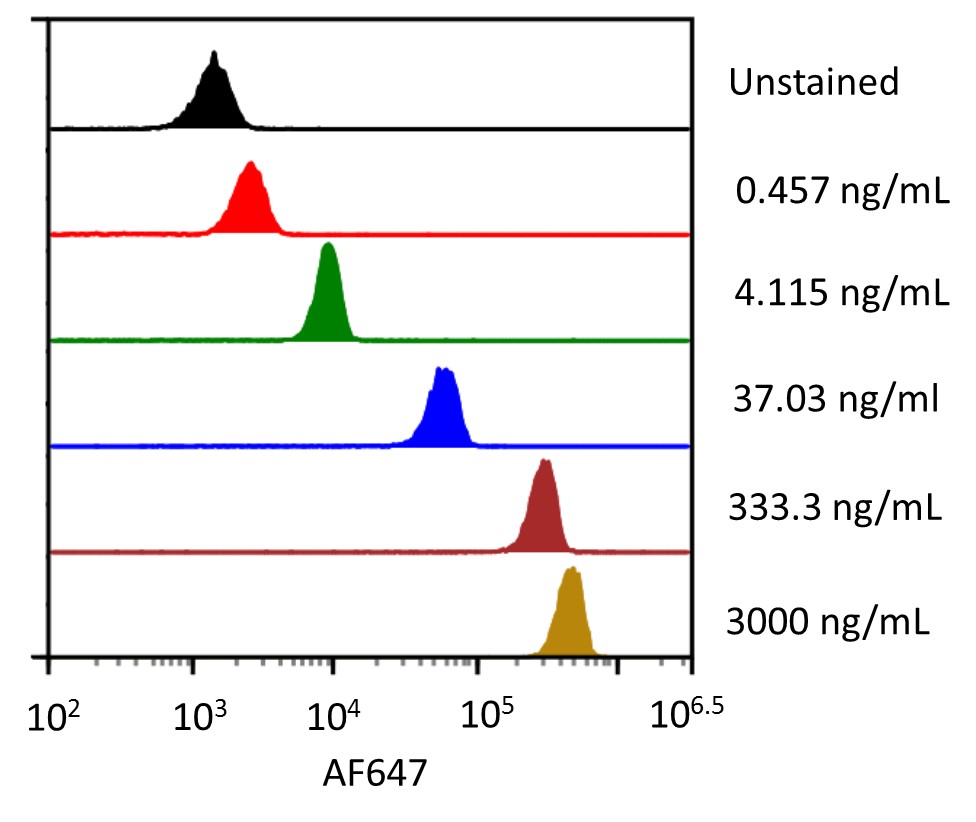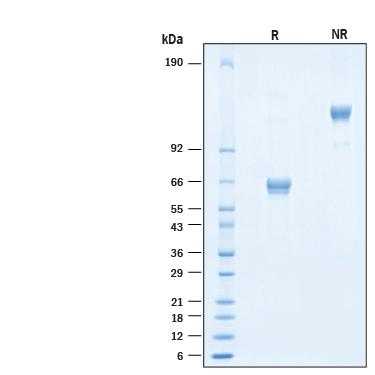Recombinant Human EMMPRIN/CD147 Fc Alexa Fluor® 647 Protein
Recombinant Human EMMPRIN/CD147 Fc Alexa Fluor® 647 Protein Summary
Learn more about FluorokinesTM Fluorescent-Labeled ProteinsProduct Specifications
| Human EMMPRIN/CD147 (Thr25-His205) Accession # NP_001309172.1 | DIEGRMD | Human IgG1 (Pro100-Lys330) | 6-His tag |
| N-terminus | C-terminus | ||
Analysis
Product Datasheets
AFR972
| Formulation | Supplied as a 0.2 μm filtered solution in PBS with BSA as a carrier protein. |
| Shipping | The product is shipped with dry ice or equivalent. Upon receipt, store it immediately at the temperature recommended below. |
| Stability & Storage: | Protect from light. Use a manual defrost freezer and avoid repeated freeze-thaw cycles.
|
Scientific Data
 View Larger
View Larger
Streptavidin coated beads conjugated to biotinylated anti-human EMMPRIN/CD147 Monoclonal Antibody were stained with the indicated concentrations of Recombinant Human EMMPRIN/CD147 Fc Chimera Alexa Fluor® 647 (Catalog # AFR972).
 View Larger
View Larger
2 μg/lane of Recombinant Human EMMPRIN/CD147 Fc Chimera His-tag Alexa Fluor® 647 Protein (Catalog # AFR972) was resolved with SDS-PAGE under reducing (R) and non-reducing (NR) conditions and visualized by Coomassie® Blue staining, showing bands at 56-69 kDa and 112-140 kDa, respectively.
Reconstitution Calculator
Background: EMMPRIN/CD147
Extracellular matrix metalloproteinase (MMP) inducer (EMMPRIN), also known as basigin and CD147, is a 44‑66 kDa, variably N‑ and O‑glycosylated, type I transmembrane protein that belongs to the immunoglobulin superfamily (1‑4). Human EMMPRIN is 269 amino acids (aa) in length and contains a 24 aa signal sequence, a 183 aa extracellular domain (ECD), a 21 aa transmembrane (TM) segment and a 41 aa cytoplasmic tail. The ECD contains one C2‑type and one V‑type Ig‑like domain. There is one 385 aa splice variant that contains an extra N‑terminal IgCAM domain and is found only in the retina (5). There are additional multiple potential isoform variants for EMMMPRIN. Two that have been characterized are 205 and 176 aa in length. The 176 aa isoform utilizes an alternative start site at Met94, while the 205 aa isoform contains an 11 aa substitution for aa 1‑75. Notably, the 176 aa isoform heterodimerizes with the standard EMMPRIN isoform and down‑modulates its activity. This is in contrast to EMMPRIN homodimers that show full biological activity (6). EMMPRIN is expressed in areas of tissue remodeling, including endometrium, placenta, skin, and regions undergoing angiogenesis (1, 2, 7‑10). It is also expressed on cells with high metabolic activity, such as lymphoblasts, macrophages and particularly tumor cells (2, 11). On such cells, EMMPRIN is often co‑expressed with the amino acid transporter CD98h (12). EMMPRIN also interacts with caveolin-1 (via its C2‑like domain), and this reduces the level of EMMPRIN glycosylation and subsequent EMMPRIN multimerization and activity (13). In addition, EMMMPRIN is reported to complex with both annexin II and beta 1 integrins alpha 3 and alpha 6, an interaction that contributes to tumor growth and metastasis (14‑16). Finally, the soluble calcium‑binding protein S100A9 has now been identified as a ligand for EMMPRIN, and may mediate many of the tumorigenic activities attributed to EMMPRIN (17). EMMPRIN’s TM sequence contains a charged aa (Glu), and a Pro important for intracellular interactions with cyclophilins (CyP) (3, 18, 19). CyPA (cyclosporin A receptor) and CyP60 interactions with the TM segment promote leukocyte inflammatory chemotaxis and surface expression of EMMPRIN, respectively (18, 19). An active 22 kDa fragment can be shed from tumor cells by MT1‑MMP (1). Tumor cells can also release active, full‑length EMMPRIN in microvesicles (20, 21). Functionally, EMMPRIN is known to induce urokinase‑type plasminogen activator (uPA), VEGF, hyaluronan and multiple MMPs (1, 2, 8‑10). Human EMMPRIN (269 aa) shows 58%, 58%, 62% and 52% aa identity with mouse, rat, cow and chick EMMPRIN, respectively. It also shows 25% and 38% aa identity with the related proteins, embigin and neuroplastin (SDR‑1), respectively.
- Gabison, E. E. et al. (2005) Biochimie 87:361.
- Yurchenko, V. et al. (2006) Immunology 117:301.
- Kasinrerk, W. et al. (1992) J. Immunol. 149:847.
- Iacono, K.T. et al. (2007) Exp. Mol. Pathol. 83:283.
- Hanna, S. M. et al. (2003) BMC Biochem. 4:17.
- Liao, C-G. et al. (2011) Mol. Cell. Biol. 31:2591.
- Riethdorf, S. et al. (2006) Int. J. Cancer 119:1800.
- Braundmeier, A. G. et al. (2006) J. Clin. Endocrinol. Metab. 91:2358.
- Tang, Y. et al. (2006) Mol. Cancer Res. 4:371.
- Quemener, C. et al. (2007) Cancer Res. 67:9.
- Wilson, M. C. et al. (2005) J. Biol. Chem. 280:27213.
- Xu, D. and M. E. Hemler, (2005) Mol. Cell. Proteomics 4:1061.
- Tang, W. et al. (2004) Mol. Biol. Cell 15:4043.
- Zhao, P. et al. (2010) Cancer Sci. 101:387.
- Dai, J. et al. (2009) BMC Cancer 9:337.
- Li, Y. et al. (2012) J. Biol. Chem. 287:4759.
- Hibino, T. et al. (2013) Cancer Res. 73:172.
- Arora, K. et al. (2005) J. Immunol. 175:517.
- Pushkarsky, T. et al. (2005) J. Biol. Chem. 280:27866.
- Egawa, N. et al. (2006) J. Biol. Chem. 281:37576.
- Sidhu, S. S. et al. (2004) Oncogene 23:956.
Product Specific Notices
This product is provided under an agreement between Life Technologies Corporation and R&D Systems, Inc, and the manufacture, use, sale or import of this product is subject to one or more US patents and corresponding non-US equivalents, owned by Life Technologies Corporation and its affiliates. The purchase of this product conveys to the buyer the non-transferable right to use the purchased amount of the product and components of the product only in research conducted by the buyer (whether the buyer is an academic or for-profit entity). The sale of this product is expressly conditioned on the buyer not using the product or its components (1) in manufacturing; (2) to provide a service, information, or data to an unaffiliated third party for payment; (3) for therapeutic, diagnostic or prophylactic purposes; (4) to resell, sell, or otherwise transfer this product or its components to any third party, or for any other commercial purpose. Life Technologies Corporation will not assert a claim against the buyer of the infringement of the above patents based on the manufacture, use or sale of a commercial product developed in research by the buyer in which this product or its components was employed, provided that neither this product nor any of its components was used in the manufacture of such product. For information on purchasing a license to this product for purposes other than research, contact Life Technologies Corporation, Cell Analysis Business Unit, Business Development, 29851 Willow Creek Road, Eugene, OR 97402, Tel: (541) 465-8300. Fax: (541) 335-0354.This product is provided under an agreement between Life Technologies Corporation and R&D Systems, Inc, and the manufacture, use, sale or import of this product is subject to one or more US patents and corresponding non-US equivalents, owned by Life Technologies Corporation and its affiliates. The purchase of this product conveys to the buyer the non-transferable right to use the purchased amount of the product and components of the product only in research conducted by the buyer (whether the buyer is an academic or for-profit entity). The sale of this product is expressly conditioned on the buyer not using the product or its components (1) in manufacturing; (2) to provide a service, information, or data to an unaffiliated third party for payment; (3) for therapeutic, diagnostic or prophylactic purposes; (4) to resell, sell, or otherwise transfer this product or its components to any third party, or for any other commercial purpose. Life Technologies Corporation will not assert a claim against the buyer of the infringement of the above patents based on the manufacture, use or sale of a commercial product developed in research by the buyer in which this product or its components was employed, provided that neither this product nor any of its components was used in the manufacture of such product. For information on purchasing a license to this product for purposes other than research, contact Life Technologies Corporation, Cell Analysis Business Unit, Business Development, 29851 Willow Creek Road, Eugene, OR 97402, Tel: (541) 465-8300. Fax: (541) 335-0354.
FAQs
No product specific FAQs exist for this product, however you may
View all Proteins and Enzyme FAQsReviews for Recombinant Human EMMPRIN/CD147 Fc Alexa Fluor® 647 Protein
There are currently no reviews for this product. Be the first to review Recombinant Human EMMPRIN/CD147 Fc Alexa Fluor® 647 Protein and earn rewards!
Have you used Recombinant Human EMMPRIN/CD147 Fc Alexa Fluor® 647 Protein?
Submit a review and receive an Amazon gift card.
$25/€18/£15/$25CAN/¥75 Yuan/¥1250 Yen for a review with an image
$10/€7/£6/$10 CAD/¥70 Yuan/¥1110 Yen for a review without an image
